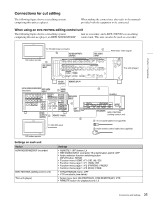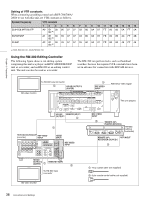Sony XDSPD2000 User Manual (XDS-PD1000 and XDS-PD2000 Operation Manual for Fir - Page 33
Front Panel Tilt Mechanism
 |
View all Sony XDSPD2000 manuals
Add to My Manuals
Save this manual to your list of manuals |
Page 33 highlights
Front Panel Tilt Mechanism The front panel of this unit has a tilt mechanism that allows you to pull the front panel out and adjust it to a convenient angle. Note Do not adjust the tilt during recording, playback, or copying. Shocks or vibrations can affect the internal storage, preventing normal recording, playback, or copying. Before adjusting the tilt, be sure to put the unit into stop mode. To pull the front panel out Press and hold in the lock release buttons on both sides of the front panel, and pull in the direction of the arrow. Note The angle cannot be fixed if you pull the front panel past position 3 all the way out to the return position. To fix the front panel, return it to position 0 and then pull it out to the desired angle. To return the front panel to its original position Unlock the front panel by pulling it out to the return position. You can then return it to position 0. To change the angle of the front panel To change to a larger angle, pull the panel up to that angle. To change to a smaller angle, pull the front panel all the way up to the return position, releasing the lock. Then return it to position 0 and pull it out again to the desired angle. Chapter 3 Preparations You can fix the angle of the front panel in position 1 (40 degrees), position 2 (65 degrees), or position 3 (90 degrees). Return position Position 3 (90 degrees) Position 2 (65 degrees) Position 1 (40 degrees) Position 0 33 Front Panel Tilt Mechanism















